Summary
Sports is produced and developed with the development of social productive forces. In its long history, due to the influence of social, political and economic development, its content, form, function and operation method are constantly changing. Major sporting events such as the Olympic Games and the World Cup represent the pinnacle of sports development, as they not only bring enormous economic benefits to the organizers, but also many immeasurable additional benefits. The success or failure of sports event management directly affects the economic benefits of sports events, which makes sports event management particularly important. As a special project, the organization and management of sports events can play a role in project implementation. Such a major sporting event is a complex system with countless software and hardware components, so sporting event management is a delicate and computational process. Any errors in the middle may lead to the failure of the final task or large errors in the calculation results. Therefore, sports management, like other management activities, requires careful planning and scheduling. This paper summarizes the theory of interest law and closed management, and analyzes the relevant theories of stakeholder management in large-scale sports events from the meaning, theoretical basis and practical basis of stakeholder management in large-scale sports events.
Keywords: sports events; Mysql database; Java
Chapter One Introduction
1.1 Research background and significance
It is necessary to study the management of sports events and understand the difference between sports management and other management activities. Jin Tao and Ding Jinglong made a detailed discussion on the management of sports events and other activities in "On Sports Events and Project Management", and believed that the difference between sports events In addition to the nature of the project, it also contains many special contents: including advertising, media, event marketing, event sponsorship, volunteer services, etc. The special event content drives and promotes the development of sports events. It is these special event content that make sports unprecedented prosperity and development. It is precisely because of these unique features that are different from other projects that the management of sports events is more complicated. With the continuous deepening of globalization, with the influence of economic, political, legal, environmental, resource and other factors in international competition, international problems caused by cross-culture. At the same time, it is also a key factor affecting the success or failure of sports events. Xie Ying pointed out in "Intercultural Risk Management in International Sports Event Management" that due to the influence of geography, economy, culture and ideology, people's differences in language, beliefs, values, etc. will lead to communication and risk management. and business practices and taboos. This shows the importance of sports management in the operation of sports events. Regarding the importance of sports event management, Huang Haiyan and Luo Lei pointed out that the sports management system determines the development model and operation mechanism of sports events in their research progress on Chinese sports event management in recent years, and plays an important role in the development of the event itself play a decisive role. The sports management system defines the structure, operation mechanism and norms of sports management from the macro level, establishes the rights and responsibilities of various sports related subjects, and reflects the interests of all related subjects. The research on the sports management system focuses on revealing the connotation, characteristics and evolution rules of the sports management system, and provides a basis for the reform and improvement of the sports management system. The success of hosting a sporting event is positively related to event management.
1.2 Research purpose
The sports event platform is aimed at sports and education authorities, schools and enterprises to realize the application of information management of sports events. The system is based on the Internet and uses various page layouts such as PCs and mobile phones to help administrators of sports events in enterprises and institutions to complete The comprehensive information management of sports event items, events, teams, personnel, registration, results and medal list, and the practicality, friendliness, high experience, automation and intelligence of the system design can effectively reduce the number of sports event management personnel in sports events. The time and energy spent in each link of the event ensures the automation, efficiency, real-time and accuracy of the summary statistics of sports event results, and improves the level of sports event management[ 2 ] .
This subject is to research and design the sports event platform , which requires the realization of user management, department management, role management, competition management and other functions. Through the analysis of the specific needs of the above content and the learning of the implementation technology, a sports event platform will be finally realized .
1.3 Research Status
Now universities in various countries hold more and more sports events, and the quality requirements are also increasing. As more and more college students enroll, the number of students who want to actively join is gradually increasing . At the same time, the cumbersome and complicated entry of various registration information and management information is a headache. If in this case, still insist on adopting the traditional way of manual sorting and collection, there is no way to meet the current needs. For the organizers, what they are very concerned about is how to help the organizers quickly and efficiently summarize and collect data by combining the current advanced information technology means . This is obviously a very intuitive and important management improvement . Therefore, it is very important to build a fully functional sports event platform to completely solve the pain points of the organizers and avoid problems such as various labor costs caused by the use of manpower and untimely collection of large amounts of information [1] .
1.4 Main work and structure of the paper
The key work of this thesis is to combine information technology and information management , and then use Java development language and MySQL database to complete the functional development of the system . The specific writing structure of this article is as follows :
Chapter One Introduction: Introduce the research background and significance, research purpose, research status and main work plan of the sports event platform .
Chapter Two System Development Tools and Technology : Introduce in detail the development tools and technology used in the system development process [ 4 ] .
Chapter 3 System Analysis : Presents and introduces the requirements analysis, feasibility analysis, performance analysis and non-functional requirements analysis of the system .
The fourth chapter overall system design : mainly introduces the overall architecture design, development process design and database design of the system .
The fifth chapter is the detailed design and implementation of the system : it introduces the system's function realization process, realization effect and core code realization .
Chapter 6 System Test: mainly introduces the test purpose, test steps and some core function tests .
Chapter 2 System Development Tools and Technologies
2.1 System Development Tools
2.1.1 IntelliJ IDEA development tools
Idea, also known as IntelliJ IDEA, provides a comprehensive platform for JAVA programming. Idea can be intelligently coded, which can reduce the amount of code for programmers in the development process. Idea can perform intelligent selection, historical records , debugging (Debug) and other functions , so as to provide convenient software for quickly completing system development.
2.1.2 Tomcat server _
Tomcat is an open source Java Web server that can meet many standard requirements of Java EE. In fact, it is a program that provides users with access to developed pages. The system development uses Tomcat7.
2.1.3 Workbench
Workbench is a data analysis and visualization platform that allows users to easily collect, organize and analyze data from multiple data sources [ 6 ] . It provides an intuitive interface that can be used to explore data, create custom reports and visualizations, and share analysis results with team members. Workbench supports a variety of data sources, including databases, cloud storage, APIs, and web applications. It also provides some built-in data connectors and converters that make it very easy to integrate data in different formats into the workspace. Workbench is also highly customizable, and its functionality can be extended through plugins and third-party applications.
2.2 System Development Technology
2.2.1 B /S structure
The B/S structure in Chinese refers to the browser/server structure, which is a client/server computing model for separating user interface and data storage. Its implementation is that the client sends out a request, and the server receives the client's request and returns a response to the client, so that the data exchange between the client and the server can be realized [ 8 ] .
2.2.2 Java
Java是一种面向对象、跨平台的高级编程语言,由Sun Microsystems(现被收购为Oracle)于1995年推出。Java的特点是可移植性好、安全可靠、易于学习和使用,被广泛应用于Web应用程序、企业级应用、嵌入式系统等领域[11]。
Java语言的核心思想是“写一次,运行到处”,也就是说,Java应用程序开发完成后,可以在不同的操作系统和硬件上运行,而无需改变任何源代码。这是因为Java应用程序在编译时会生成字节码文件,并且这些字节码可以在Java虚拟机上运行。虚拟机提供了一个独立于操作系统和硬件平台的环境,使得Java应用程序获得了很好的跨平台性。
Java还注重安全性,在设计上对内存管理、异常处理、线程同步等内容进行了规范化处理,避免了C++等底层语言容易导致程序崩溃、内存泄漏等问题。同时,Java提供了一套完整的安全 API 来保障网络程序的数据安全性。Java语言是一门优秀的面向对象编程语言,它具有跨平台性、安全性、易学易用等特点。在Web应用程序、企业级应用、游戏开发、移动应用程序等各个领域都有广泛应用。
2.2.3 SSM框架
SSM is an integration of three frameworks: Spring, MyBatis , and SpringMVC . Spring is regarded as a powerful integrated system, which can safely build beans, while MyBatis adopts a more flexible way to manage JDBC, which allows users to control all aspects of the database by simply entering a sql command. Entities, so as to complete the management of them. SpringMVC is used to intercept requests , and the core Servlet is DispatcherServlet [ 2] .
The integration of the SSM framework can make it easier for developers to develop web applications. The combination of the three frameworks enables developers to build modern Java Web applications faster and achieve good maintainability, scalability and testability [ 4 ] .
2.2.4 JSP
JSP is a dynamic web technology standard, referred to as (JavaServer Pages). It is a file formed by adding JAVA code to traditional HTML, which can provide users with dynamic data. The WEB application developed by JSP is cross-platform and can run under different operating systems. JSP separates webpage logic from webpage design and display, supports the design of reusable components, and makes developing web-based applications faster and easier.
2.2.5 MySQL database
MySQL is an open source relational database management system. It is one of the most popular open source databases and one of the most commonly used databases in web application development [2] . MySQL can support multiple types of operating systems such as Windows and Linux, as well as various programming languages such as Java.
The database has a wide range of applications, including Web applications, e-commerce, finance, games, media and other fields. MySQL has the characteristics of high performance, scalability, security, ease of use, and open source, and can meet the needs of applications of different scales and complexity. With the development of big data and cloud computing technology, MySQL will continue to play an important role in providing efficient and reliable data management services for various application scenarios.
Chapter Three System Analysis
3.1 Demand analysis
Before any project can be developed, the requirements of the development system itself need to be carefully analyzed. Market research cannot be ignored. The user's functional requirements need to be determined from the actual scene in order to clarify the goal and have a more accurate positioning for the development of the entire system. In this section, it is necessary to analyze the system performance, business process and data in order to have a more comprehensive understanding of the project. The overall interface of the university sports event management system is simple and the functions are complete.
If your development system does not meet the discussed requirements and provide useful functionality, then the system is considered a development failure. Therefore, before developing the system, it is necessary to determine the functions and requirements required by the system and ensure that the developed system can meet these requirements. The actual needs of the university sports event management system are analyzed below.
System design should start from the perspective of users and administrators, understand their actual needs, determine what functions need to be implemented, and what management work needs to be included. This ensures that the system can meet the needs of users and administrators, and improves the availability and ease of use of the system.
Considering the characteristics of the design of the university sports event management system, several requirements should be met:
(1) It can better display personal style through the network.
(2) It provides a free channel to ensure real-time and effective communication of data.
3.2 Feasibility analysis
Feasibility analysis refers to the feasibility analysis and demonstration of the system from different levels after the completion of the system requirements analysis and before the development of the system. Only after the system has all kinds of feasibility can the system start to develop. The development stage will face many various problems. Below we analyze and introduce the feasibility of the system from several aspects.
3.2.1 Technical Feasibility
The model adopted by this system is the B/S framework and the MVC development model, which mainly includes two functional modules of the user and the administrator, and the content maintenance of the database. The development tools used in system development are IDEA, MySQL database, Spring, and Mybatis back-end framework, and technologies such as layui, html, and css are used in front-end page development [7] . These technologies have been learned, and free learning materials can also be found on the Internet, so there are no technical difficulties and feasible.
3.2.2 Economic feasibility
The development tools IDEA and database MySQL used in the development of the system can be found on the Internet without paying for deciphered versions, including the development technologies used are all open source. Therefore, there are no costs to be paid. After the development is completed, there is no need for extra publicity costs, so the economic feasibility of the system is no problem.
3.2.3 Operational Feasibility
The development purpose of this system is centered on user experience, and is committed to creating a beautiful, concise and easy-to-use system. Our goal is to make the system easy to use and manage for all users, regardless of their computer skills. Therefore, we pay attention to the ease of operation and friendliness of the system to ensure that users can get started quickly and enjoy the convenience of using the system . Therefore, it is operationally feasible [ 10] .
3.3 Performance Analysis
在现在互联网大背景的冲击下,特别传统的需要使用人力去做各类数据采集、登记的方式已经很难与现在发展中的社会相适应。因为传统的方式不仅需要用到的人力、物力都非常多,而且需要的时间也比较长、效率也是非常低下的,且随着还会很多不能避免的问题失误等。因此,为了提高效率、提高精确性可开发一套大学生体育赛事平台来帮助解决这些问题,从而效率也会随着提高。
本系统它是一个独立的系统,采用了主流的轻量级Mysql数据库。实现了使用本系统时不同用户角色拥有了不同的功能,各司其事各干其事。从而,数据全部通过系统管理采集就节省了很多人力、财务、物力,且数据归档存储规范化、有历史记录保证不会出现丢失、混乱等情况。
3.4 非功能性需求分析
随着用户数量的增加,系统可能需要同时服务于数千或数万个页面,并且服务器需要同时响应大量的用户操作。这要求系统具有良好的可扩展性,否则系统可能会出现延迟、卡顿或甚至服务器崩溃的情况。为了保持软件的活力,系统需要具备高可扩展性,以适应用户增长、性能需求改进和应用功能增加等变化。同时,系统存储了大量用户和管理员的个人信息,因此在开发过程中必须考虑确保服务器和数据的安全。这包括服务器、操作系统、数据库、程序代码以及用户个人信息和支付安全等方面的安全。为了增强系统的安全性,可以采用防火墙技术、加密技术、认证技术等。只有一个强大而安全的系统才能长期保持活力。
第四章 系统总体设计
4.1 系统架构设计
这个大学体育赛事平台项目的概览设计分析主要集中在大学体育赛事管理系统的具体分析上。采用MySQL数据库设计,系统设计采用更加用户友好的操作设计。系统中出现的任何错误信息都可以及时处理并反馈。
The university sports event platform is based on the existing network development, which can realize detailed understanding and statistical analysis of administrators and user management (administrators, users), as well as more management (event event application management, budget application management, personal registration management , team registration, project completion management, etc.). Realize users: homepage, event management, budget application, etc. The module relationship diagram established based on the system functional requirements is shown in the following figure:
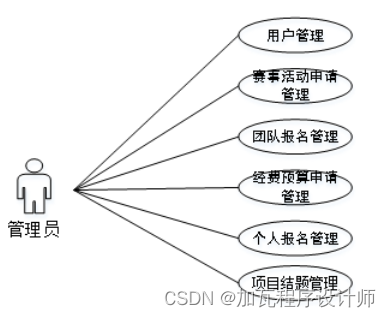
Figure 1 Administrator function module diagram
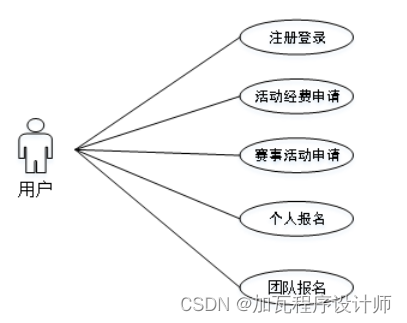
Figure 2 User function module diagram
The above functional information can meet the needs of this system. The overall functional structure diagram of this system is shown in Figure 3 , which mainly includes two parts: users and administrators .
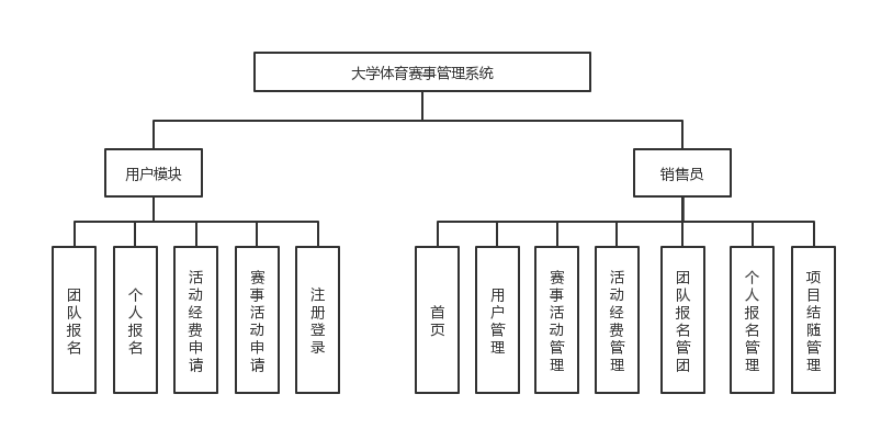 Figure 3 System function structure diagram
Figure 3 System function structure diagram
4.2 Development process design
There are three necessary steps to develop a college sports event platform: analytical system usage of management modules and databases, authoring agent development, and planning and operation. These steps are necessary to build an information management application, and they determine whether the system can actually achieve the intended function and whether it can be implemented after successful design. In the development process, each stage must be developed in a linear order, and each work generated by each stage can be verified and checked by technology. This ensures that completing one phase is done correctly and does not drag and drag on the next phase, ensuring that the system is safeguarded once it has completed its designed functionality.
The successful development experience of the university sports event platform shows that the above method can minimize the complexity of system development and achieve obvious results. Specifically, this method can make system development easier to understand, improve development efficiency, and reduce development costs. Therefore, this method is a very effective way of development. The development process is shown in Figure 4.
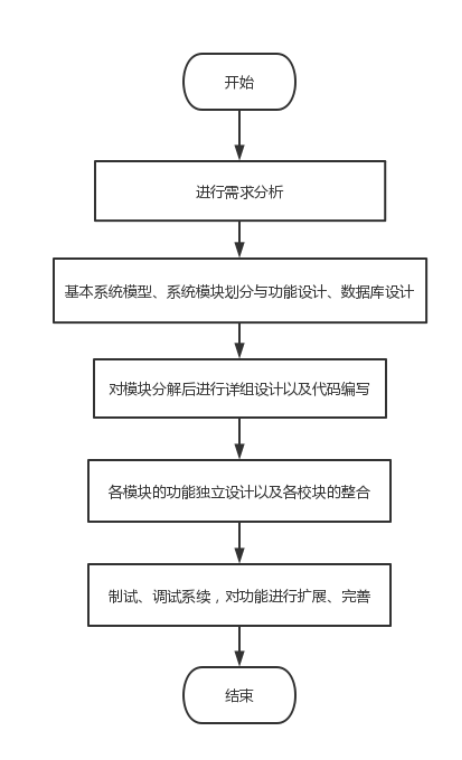
Figure 4 Flowchart of the development system
4.3 Database table structure design
According to the requirements of the input and output data volume, we can analyze the data structure in detail, and determine the relationship and structure between different tables to meet the user's needs for data and functions. Through verification, adjustment and improvement, we can realize the database and provide query and browsing functions so that users can use the data better.
The table structure design of the system is as follows.
(1) User table
Table 1 User Table
| Field Name |
describe |
type of data |
range |
|
| id |
User ID |
int |
11 |
|
| user_name |
用户账号 |
varchar |
64 |
|
| user_real |
真实姓名 |
varchar |
64 |
|
| sex |
性别 |
varchar |
64 |
|
| deptid |
所属部门 |
varchar |
64 |
|
| roleid |
角色id |
varchar |
64 |
|
(2)赛事经费申请表
表2 赛事经费申请表
| 字段名称 |
描述 |
数据类型 |
值域 |
|
| budget_application_id |
ID |
int |
11 |
|
| event_number |
赛事编号 |
varchar |
64 |
|
| entry_name |
赛事名称 |
varchar |
64 |
|
| registration_fee |
注册费用 |
varchar |
64 |
|
| rate_difference_fee |
差旅费用 |
varchar |
64 |
|
| training_fee |
培训花费 |
varchar |
64 |
|
| guidance_fee |
指导花销 |
varchar |
64 |
|
| consumables |
耗材金额 |
varchar |
64 |
|
| teacher_bonus |
老师奖金 |
varchar |
64 |
|
| other |
申请用户 |
varchar |
64 |
|
| examine_state |
审核状态 |
varchar |
16 |
|
(3)赛事活动管理表
表3 参赛活动管理表
| 字段名称 |
描述 |
数据类型 |
值域 |
|
| event_application_id |
ID |
int |
11 |
|
| event_name |
赛事名 |
varchar |
64 |
|
| event_type |
类型 |
varchar |
64 |
|
| event_number |
编号 |
varchar |
64 |
|
| group_competition_unit |
组织赛事单位 |
varchar |
64 |
|
| project_leader |
负责人 |
varchar |
64 |
|
| contact_number |
电话 |
varchar |
16 |
|
| start_date |
开始时间 |
date |
0 |
|
| end_date |
end time |
date |
0 |
|
| organizer |
Organizer name |
varchar |
64 |
|
| group_significance |
Significance of the event |
varchar |
64 |
|
(4) Personal registration form
Form 4 Individual Registration Form
| Field Name |
describe |
type of data |
range |
|
| individual_registration_id |
ID |
int |
11 |
|
| event_name |
Event name |
varchar |
64 |
|
| event_type |
type |
varchar |
64 |
|
| user_name |
username _ |
int |
11 |
|
| college_name |
college |
varchar |
64 |
|
| class_name |
class |
varchar |
64 |
|
| grade_name |
grade |
varchar |
64 |
|
| professional_name |
major |
date |
64 |
|
| contact_number |
Contact information |
date |
64 |
|
| user_mailbox |
|
varchar |
64 |
|
(5) Team registration form
Form 5 Team registration form
| Field Name |
describe |
type of data |
range |
|
| team_registration_id |
ID |
int |
11 |
|
| event_name |
Event name |
varchar |
64 |
|
| event_type |
type |
varchar |
64 |
|
| event_number |
serial number |
varchar |
64 |
|
| user_name |
username _ |
int |
11 |
|
| team_name |
team name |
varchar |
64 |
|
| number_of_teams |
number of people |
varchar |
64 |
|
(6) Project end table
Table 6 Project end table
| Field Name |
describe |
type of data |
range |
|
| project_conclusion_id |
ID |
int |
11 |
|
| event_name |
Event name |
varchar |
64 |
|
| event_type |
Event type |
varchar |
64 |
|
| user_name |
username |
int |
11 |
|
| prize_awarded_ |
Awards |
varchar |
64 |
|
| total_use_of_funds |
Total funds used |
varchar |
64 |
|
Chapter 5 Detailed Design and Implementation of the System
5.1 Realization of user function modules
The functions implemented by the client terminal mainly include user registration, login, event viewing, event registration, event funding application, personal application records, and event registration record viewing functions.
5.1.1 User registration _ _
用户输入用户名、密码、性别、角色等信息后,点击“注册”按钮,注册成功跳转至用户登录页面进行登录。注册流程如图6所示。
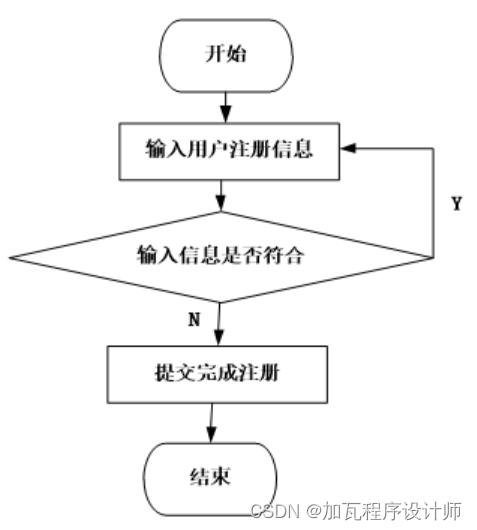
图6 用户注册功能流程图
用户注册功能的实现界面效果如图7所示。
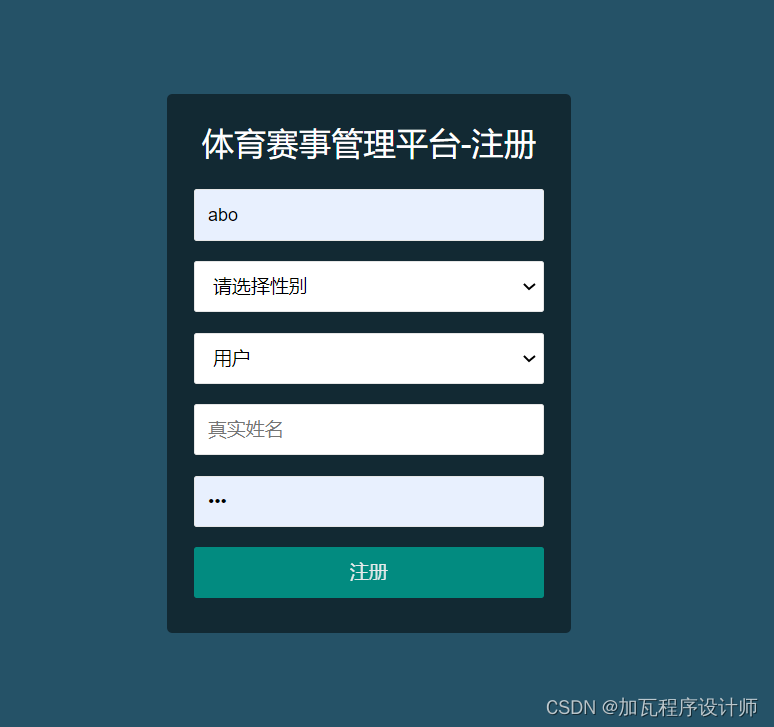
图7 用户注册实现效果图
用户注册功能的关键实现代码截图如图8所示。

图8 用户注册关键代码截图
5.1.2 用户登录
登录的目的是为了提高系统的安全性,只有通过验证的用户才可以登录系统进行使用。用户进入系统的登录页面,填写用户账号、密码,点击“登录”按钮进入至系统首页。登录功能实现界面效果如图9所示。

图9 用户登录实现效果图
用户登录功能的关键实现代码截图如图10所示。
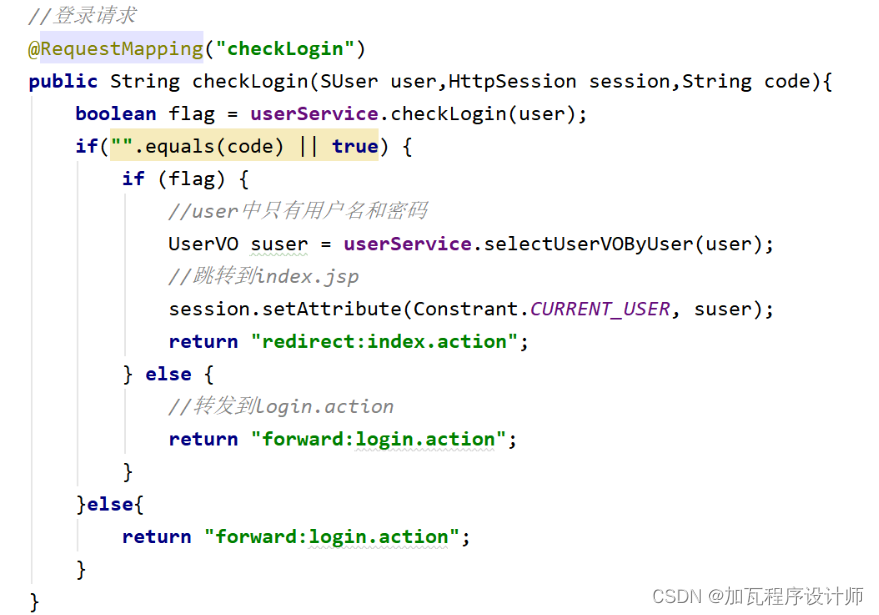
图10 用户登录关键代码截图
5.1.3 个人报名
用户点击赛事报名,进入赛事信息的列表,在里面筛选出自己想要报名的赛事,在操作里面点击“个人报名”,进入报名信息填写页面,输入学院名称、班级名称、年级名称、专业名称、联系电话等信息后保存完成报名。个人报名流程如图11所示。

图11 个人报名流程图
个人报名信息填写界面实现效果如图12所示。

图12 个人报名信息填写界面
个人报名功能的关键实现代码截图如图13所示。

图13 个人报名关键代码截图
5.1.4 团队报名
用户点击赛事报名,进入赛事信息的列表,在里面筛选出自己想要报名的赛事,在操作里面点击“团队报名”,进入报名信息填写页面,输入团队名称、团队人数信息后保存完成报名。团队报名流程如图14所示。

图14 团队报名流程图
团队报名信息填写界面实现效果如图15所示。
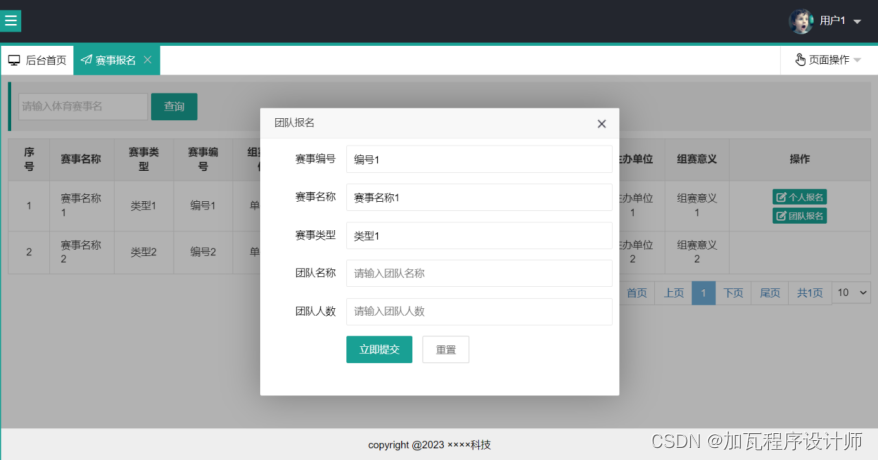
图15 团队报名信息填写界面
团队报名功能的关键实现代码截图如图16所示。
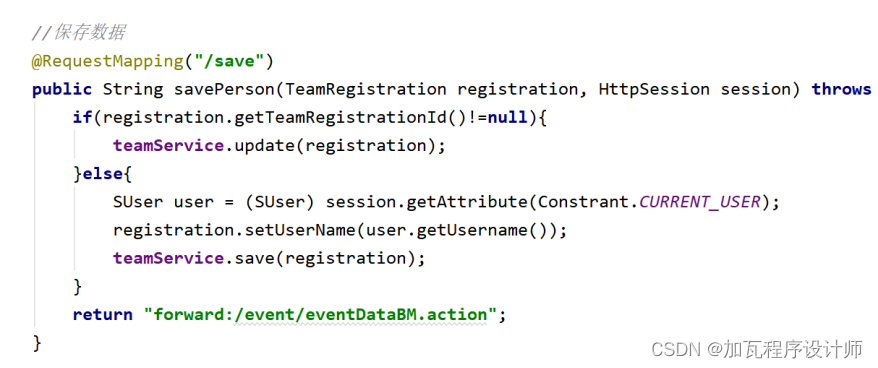
图16 团队报名关键代码截图
5.1.5 赛事经费申请
用户点击赛事经费申请,进入赛事信息展示列表,在本界面筛选自己需要申请经费的赛事,点击操作里面的“申请”按钮,在经费申请信息填写界面输入参赛注册费、差旅费、培训费、指导费等信息后进行提交,等待审核。赛事经费申请实现流程如图17所示。

图17 赛事经费申请流程图
赛事经费申请信息填写界面实现效果如图18所示。

图18 赛事经费申请信息填写界面
赛事经费申请功能的关键实现代码截图如图19所示。
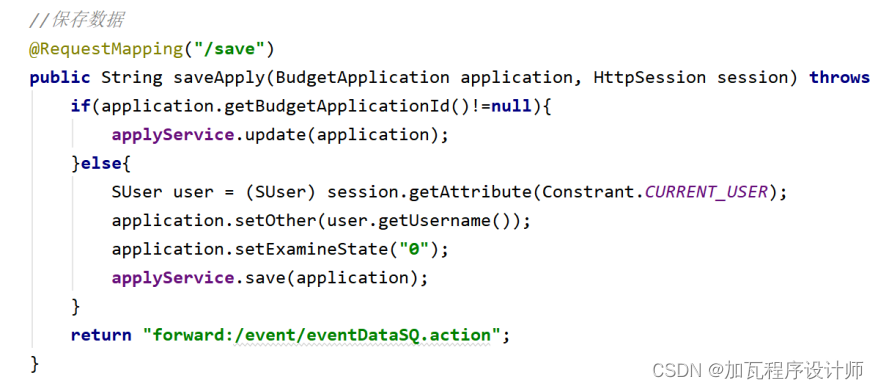
图19 赛事经费申请关键代码截图
5.2 管理员功能模块实现
管理员端实现的功能主要包括了管理员登录、用户管理、角色管理、资源权限分配、赛事信息管理、赛事经费申请审核、个人报名信息查看、团队报名信息查看、项目结题等功能。
5.2.1 赛事信息管理
赛事信息管理包括了赛事的发布、查询、修改、删除等操作。赛事信息是将相关能参加的赛事进行统一管理,方便用户报名、查看。具体实现效果如图20所示。
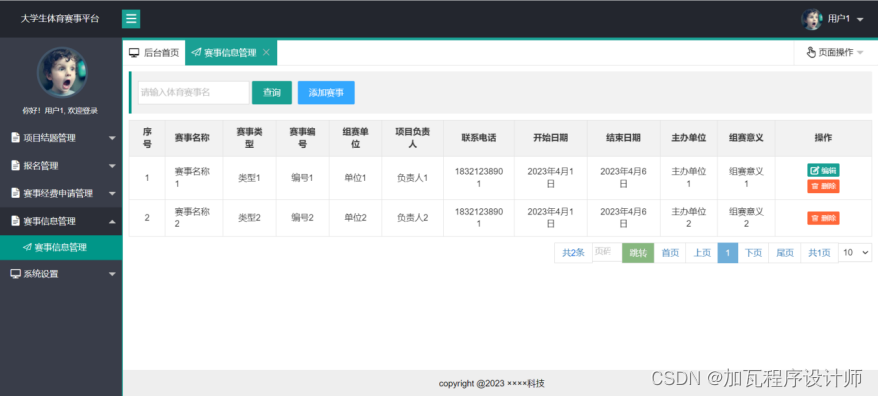
图20 赛事信息管理界面
赛事信息管理功能的关键实现代码截图如图21所示。
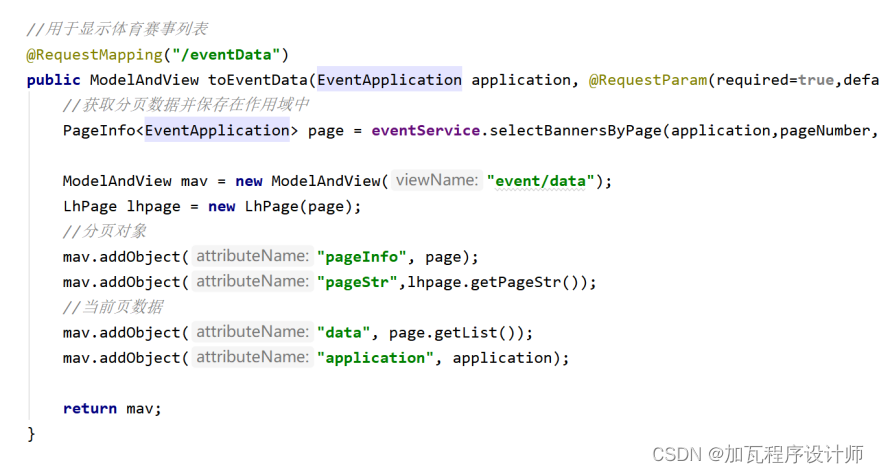
图21 赛事信息管理关键代码截图
5.2.2 赛事经费审核
赛事经费审核是对用户提交的经费申请信息进行审核,看用户提交的经费是否合理,若合理审核通过;否则,审核驳回。具体实现效果如图22所示。

图22 赛事经费审核效果图
赛事经费审核功能的关键实现代码截图如图23所示。
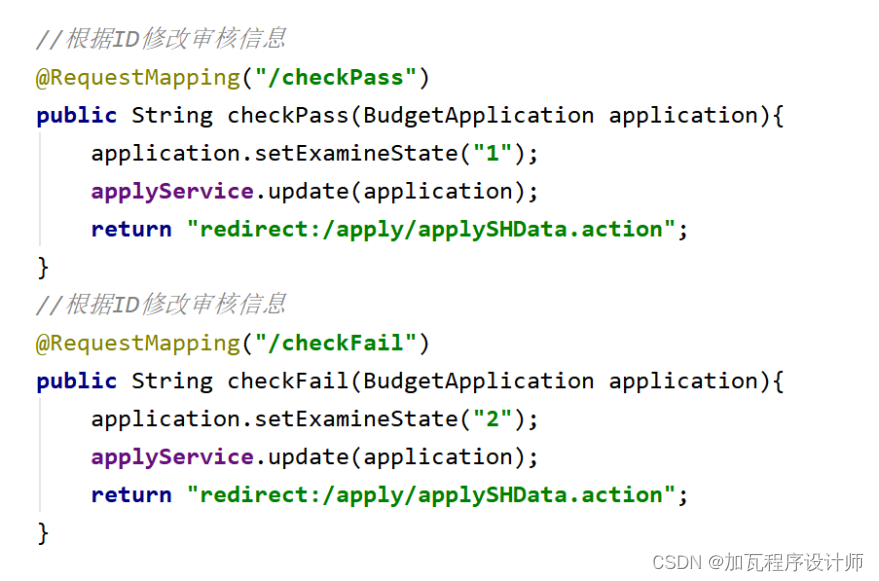
图23 赛事经费审核关键代码截图
5.2.3 个人报名
个人报名是对用户提交的个人报名信息进行查询、查看,管理员权限下是可以查看到全部用户的个人报名信息。具体实现效果如图24所示。
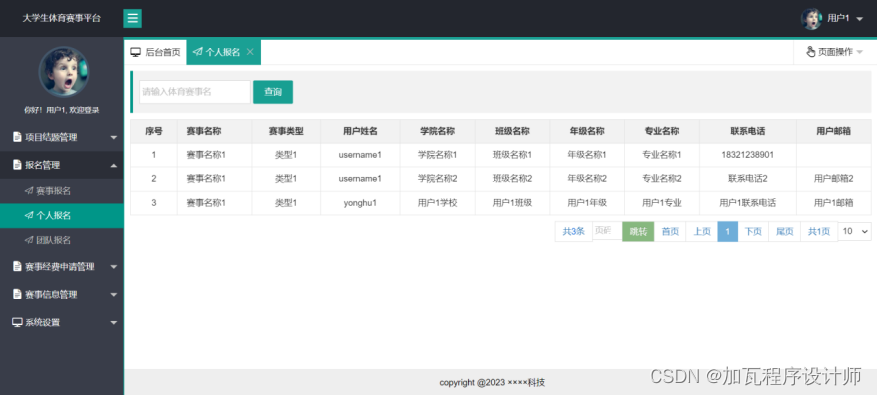 图24 个人报名实现效果图
图24 个人报名实现效果图
个人报名功能的关键实现代码截图如图25所示。

图25个人报名功能关键代码截图
5.2.4 团队报名
团队报名是对用户提交的团队报名信息进行查询、查看,管理员权限下是可以查看到全部用户的团队报名信息。具体实现效果如图26所示。

图26 团队报名实现效果图
团队报名功能的关键实现代码截图如图27所示。

图27团队报名功能关键代码截图
5.2.5 项目结题
项目结题将赛事信息进行展示,在里面筛选需要进行结题的项目,点击“结题记录”操作,进入结题记录界面输入用户名、名次等相关信息。在全部的结题记录输入完成后,点击“赛事结束”操作,此赛事将直接终止,不再能进行任何操作信息。具体实现效果如图28所示。
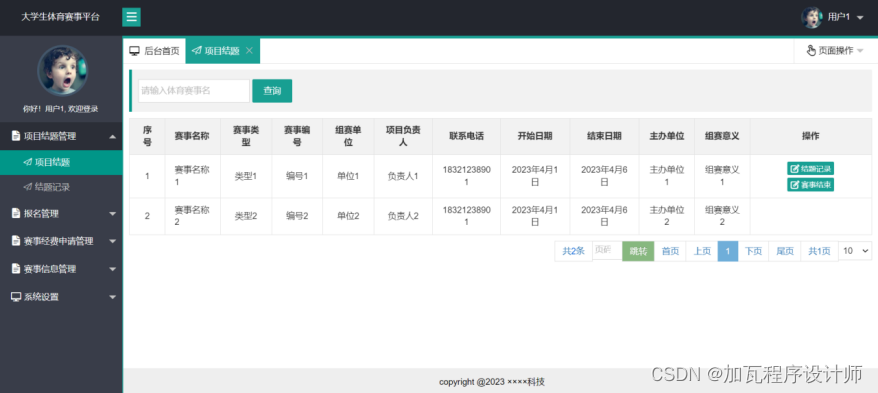
图28 项目结题实现效果图
项目结题功能的关键实现代码截图如图29所示。

图29赛事结题功能关键代码截图
5.2.6 结题记录
结题记录是管理赛事的全部的结题记录信息,可以输入赛事名称信息去筛选项看到的结题记录信息。具体实现效果如图30所示。
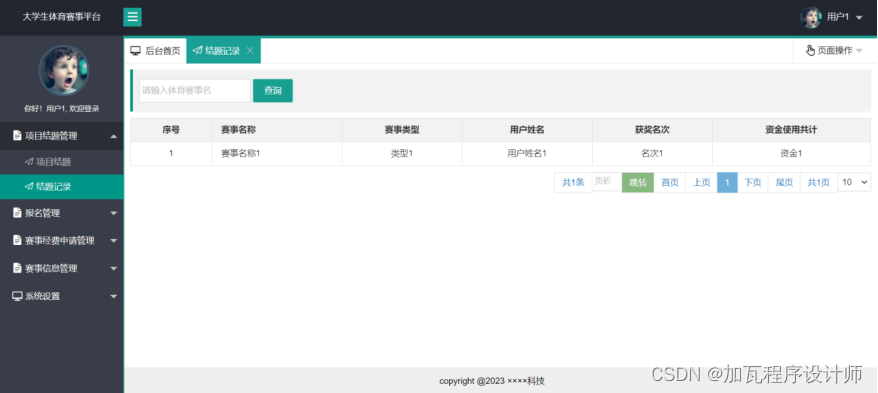
图30结题记录实现效果
项目记录功能的关键实现代码截图如图31所示。

图31结题记录功能关键代码截图
5.2.7 用户管理
用户管理模块是对后台管理员的用户信息进行统一管理,主要包括了姓名、登录名、性别、所属部门、所属角色、最后登录时间、状态等信息,涵盖的操作主要有新增、删除、修改查询。用户管理模块的界面如图32所示。

图32 用户管理界面
5.2.8 部门管理
部门管理模块是对后台管理员的部门信息进行统一管理,主要包括了部门名称、状态信息,涵盖的操作主要有新增、删除、修改查询。部门管理模块的界面如图33所示。
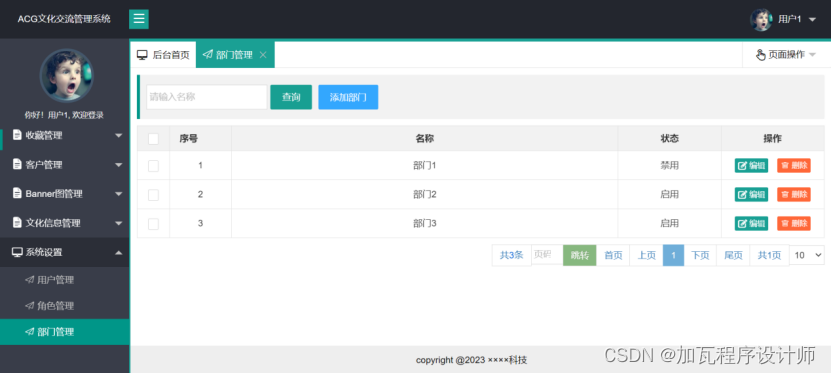
图33 部门管理界面
5.2.9 角色管理
角色管理模块是对后台管理员的角色信息进行统一管理,主要包括了角色名称、状态信息,涵盖的操作主要有查询库里的角色、添加新角色、删除角色、分配权限菜单等操作。角色管理模块的界面如图34所示。
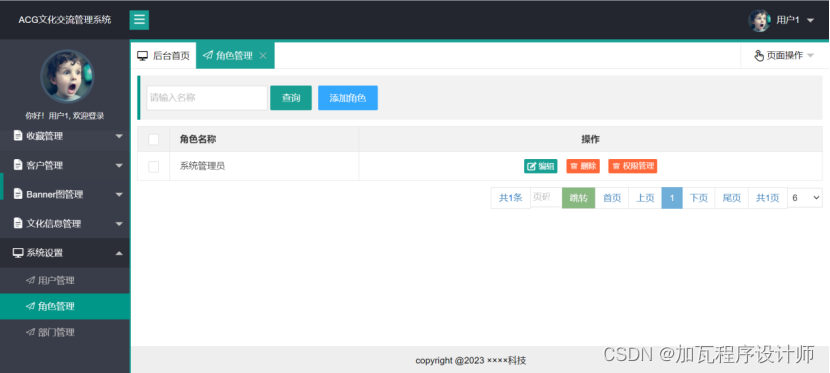
图34 角色管理界面
第六章 系统详细设计与实现
6.1 软件测试目的
测试是想要发现系统里面存在错误、缺陷及其漏洞,并且把这些进行修改调整,以确保软件产品的质量和稳定性,提高用户的满意度和信任度。同时,软件测试也可以帮助开发团队发现潜在的问题,并为软件产品的改进提供支持。
6.2 软件测试步骤
(1)模块化测试,该测试需将整体的系统功能拆分成一个一个小模块,然后按照模块化进行测试,在测试过程中将每个小模块里面的问题找出来并记录好,从而把问题都一一解决并完善好。
(2)整体性测试,系统按照模块化把功能都测试完成后,再把小模块的内容全部整合到一起测试,按照需求整理好系统整体流程,梳理好整体流程。按照整体确定的流程完成系统整体测试,使各个模块有密切联系,这样做才可完成确定的操作流程;
(3)测试结果验收,在项目验收之前多次测试,在确保没问题情况下即可交付客户。
6.3 核心功能测试
(1)后台登录功能
测试用例及结果如表7所示
表7 登录功能测试表
| 测试模块 |
测试用例 |
预期结果 |
测试结果 |
|
| 登录 |
{ “18435122378”, “123456” } |
用户不存在 |
与实际结果一致 |
|
| { “18435122379”, “123456” } |
密码错误 |
与实际结果一致 |
||
| { “18435122379”, “123456” } |
登录成功 |
与实际结果一致 |
||
| { “18435122379 ”, “ ” } |
提示密码必填 |
与实际结果一致 |
||
| { “ ”, “18435122379 ” } |
提示账号必填 |
与实际结果一致 |
||
(2)用户注册功能
测试用例及结果如表7所示
表7 注册功能测试表
| 测试模块 |
测试用例 |
预期结果 |
测试结果 |
|
| 注册 |
{ “18435122378”, “名字”, “123456”,“1”,“1” } |
注册成功 |
与实际结果一致 |
|
| { “18435122378”, “名字”, “123456”,“”,“1” } |
用户角色不能为空 |
与实际结果一致 |
||
| { “18435122378”, “名字”, “123456”,“1”,“” } |
用户性别不能为空 |
与实际结果一致 |
||
| { “18435122378”, “名字”, “”,“1”,“1” } |
提示密码必填 |
与实际结果一致 |
||
| { “”, “名字”, “123456”,“1”,“1” } |
提示账号必填 |
与实际结果一致 |
||
(3)团队报名功能
测试用例及结果如表8所示
表8 团队报名功能测试表
| 测试模块 |
测试用例 |
预期结果 |
测试结果 |
|
| 团队报名 |
{ “赛事1”, “类型1”, “编号user”,“团队名”,“人数” } |
注册成功 |
与实际结果一致 |
|
| { “赛事1”, “类型1”, “编号user”,“”,“人数” } |
提示团队名不能为空 |
与实际结果一致 |
||
| { " event 1 ", " type 1 ", " number user " , "team name", "" } |
Prompt that the number of teams cannot be empty |
consistent with actual results |
||
(4) Event fund application function
The test cases and results are shown in Table 9
Table 9 Functional Test Form for Event Fund Application
| test module |
test case |
expected outcome |
Test Results |
|
| Event funding application |
{ " event 1 ", " number " , "10", "10", “10”,“10”,“10”,“10”, “user” } |
added successfully |
consistent with actual results |
|
| { "", " Number " , "10", "10", “10”,“10”,“10”,“10”, “user” } |
Prompt that the event name cannot be empty |
consistent with actual results |
||
| { " event 1 ", " number " , "10", "10", “10”,“10”,“10”,“10”, “user” } |
Prompt that the event number cannot be empty |
consistent with actual results |
||
Like, like, favorite, add attention to the author of private letter